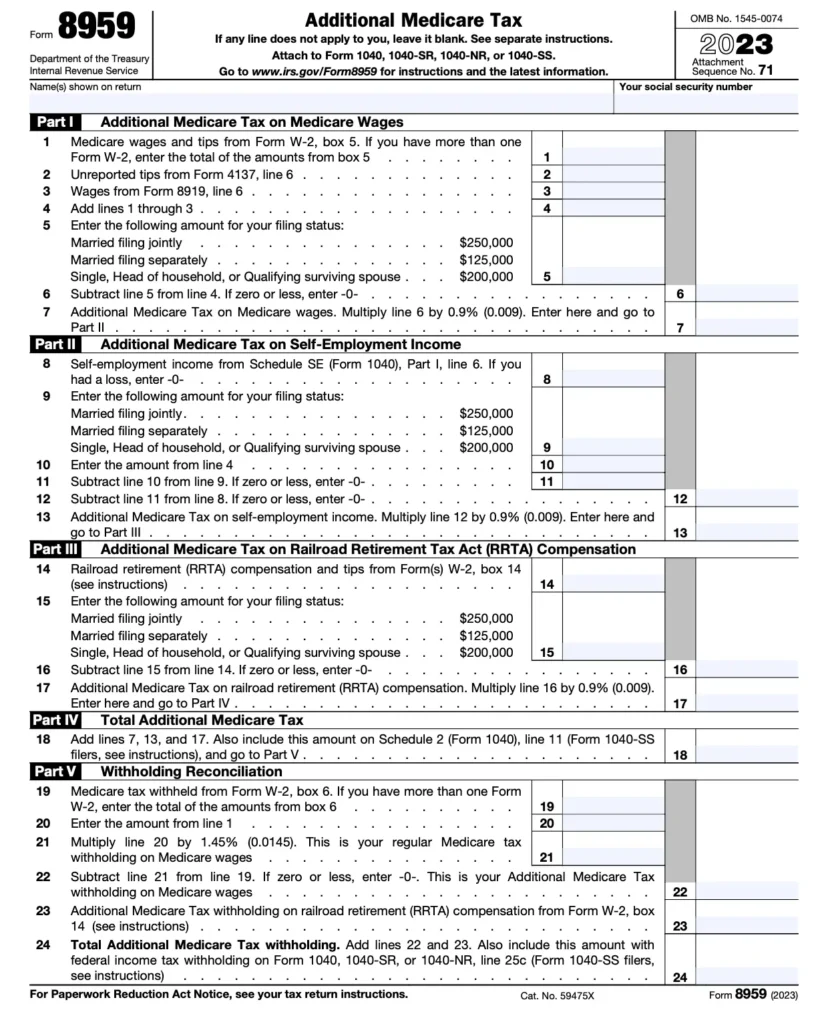IRS Form 8959, titled “Additional Medicare Tax,” calculates and reports the Additional Medicare Tax owed by high-income earners. This tax applies to wages, self-employment income, and other compensation exceeding specific thresholds. Filing Form 8959 ensures compliance with IRS regulations and avoids penalties. For complex cases or uncertainty, professional tax services can simplify the process.
Who Needs to File Form 8959?
You must file Form 8959 if:
Your wages or self-employment income exceeds:
- $200,000 (single filers).
- $250,000 (married filing jointly).
- $125,000 (married filing separately).
You received railroad retirement (RRTA) compensation exceeding the thresholds above.
If you’re unsure whether you owe Additional Medicare Tax, consult tax services to review your income.

Step-by-Step Guide to Filling Out Form 8959
Step 1: Gather Required Information
Before starting, collect:
- W-2 forms (for wages).
- Schedule SE (for self-employment income).
- Records of RRTA compensation (if applicable).
Step 2: Complete Part I – Additional Medicare Tax on Wages
Line 1: Enter total Medicare wages from all W-2s (Box 5).
Line 2: Input your filing status threshold (e.g., $200,000 for single filers).
Line 3: Subtract Line 2 from Line 1. If negative, enter $0.
Line 4: Multiply Line 3 by 0.9% (the Additional Medicare Tax rate).

Step 3: Complete Part II – Additional Medicare Tax on Self-Employment Income
Line 5: Enter net self-employment income (from Schedule SE, Line 6).
Line 6: Add your total wages (Line 1) to Line 5.
Line 7: Subtract your filing status threshold (Line 2) from Line 6. If negative, enter $0.
Line 8: Multiply Line 7 by 0.9%.
Step 4: Complete Part III – Total Additional Medicare Tax
Line 9: Add Lines 4 and 8. This is your total Additional Medicare Tax owed.
Line 10: Enter any Additional Medicare Tax already withheld from wages (W-2 Box 6).
Line 11: Subtract Line 10 from Line 9. If positive, this is the amount you owe. If negative, enter $0.
Step 5: Attach Form 8959 to Your Tax Return
- Include Form 8959 when filing your federal tax return (Form 1040).
- Transfer the amount from Line 11 to Form 1040, Schedule 2, Line 11.
Common Mistakes to Avoid
- Ignoring thresholds: Tax applies only to income exceeding your filing status limit.
- Miscalculating self-employment tax: Use Schedule SE to determine net self-employment income.
- Missing deadlines: File by April 15 (or October 15 with an extension).
For error-free filing, partner with tax services specializing in high-income tax compliance.

Final Thoughts
Filing IRS Form 8959 ensures you accurately report and pay Additional Medicare Tax on high-income earnings. By following these steps, you can avoid errors and stay compliant. For complex income scenarios or audits, professional tax services provide expertise and peace of mind.










